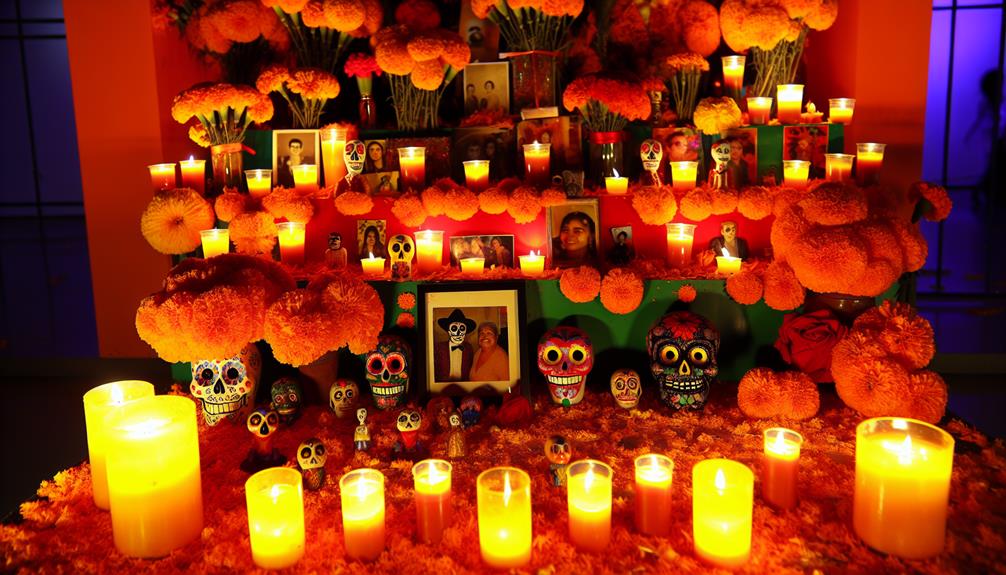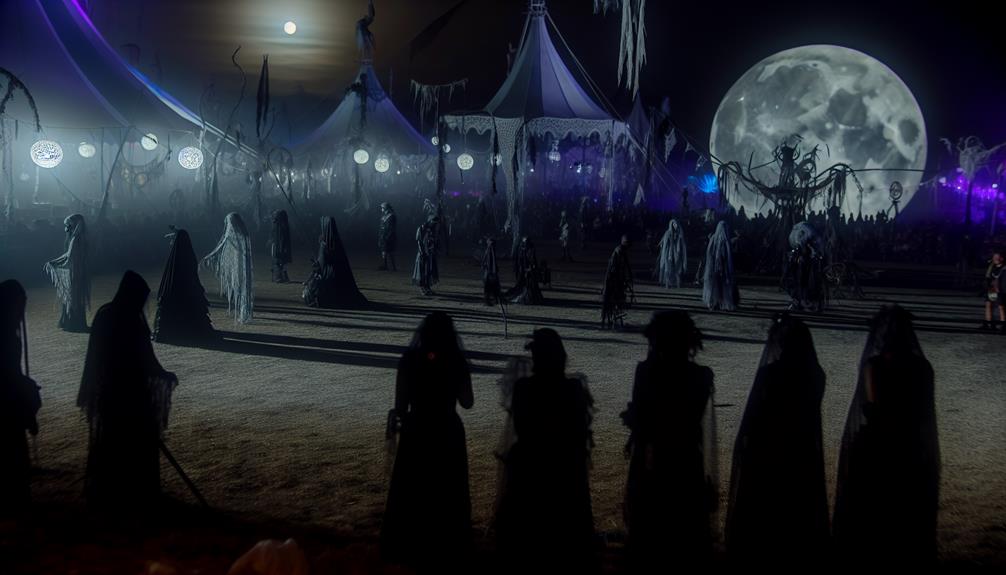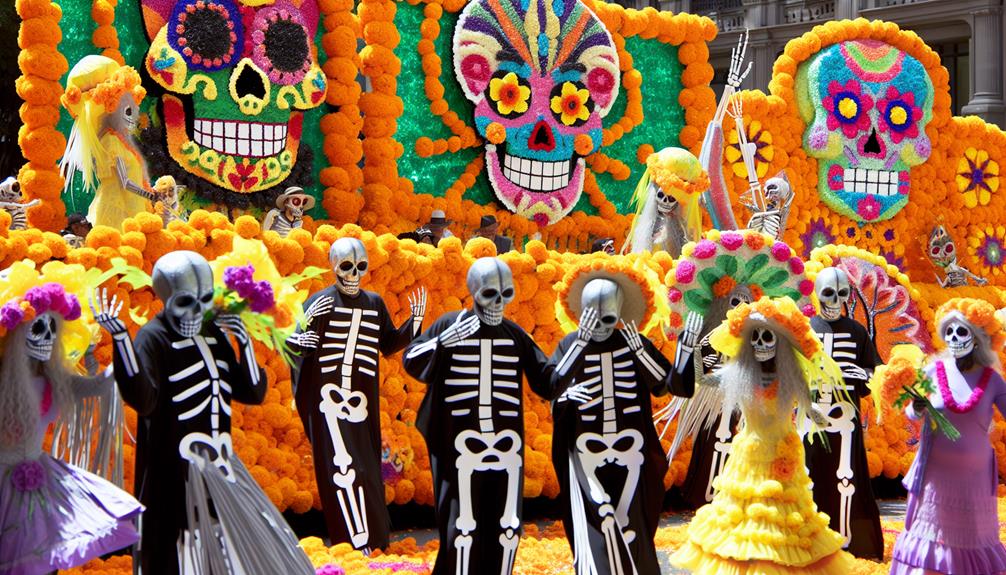The Day of the Dead in Mexico encapsulates a rich tapestry of cultural heritage and spiritual significance that transcends time. This cherished tradition, steeped in ancient rituals and folklore, provides a profound insight into the profound connection Mexican communities have with their ancestors. By exploring the intricate altars, vibrant decorations, and symbolic offerings that define this commemorative event, one can uncover a world where life, death, and tradition intersect in a mesmerizing display of reverence and celebration. This cultural phenomenon offers a glimpse into a domain where the past and present merge seamlessly, inviting contemplation on the enduring legacy of ancestral remembrance in Mexican society.
Key Takeaways
- Traditional Mesoamerican roots blend with Catholic influences
- Symbolic elements like marigolds, sugar skulls, and butterflies abound
- Altars with ofrendas honor deceased ancestors
- Festive foods like mole and Pan de Muerto are enjoyed
- Music and dance play a vital role in joyful celebrations
Origins of Day of the Dead
The origins of Day of the Dead can be traced back to ancient Mesoamerican civilizations, where rituals honoring deceased ancestors were an integral part of their cultural practices. This tradition holds immense cultural significance and historical roots, with the festivities evolving over centuries into the vibrant celebration known today. Ancestral honoring is at the core of Day of the Dead, reflecting a deep spiritual connection between the living and the departed.
In pre-Hispanic times, various Mesoamerican civilizations such as the Aztecs, Maya, Purepecha, Nahua, and Totonac held rituals to commemorate and pay homage to their ancestors. These rituals often involved offerings, ceremonies, and gatherings to honor the deceased and ensure their spirits continued to exist in the afterlife. The belief in the cyclical nature of life and death, where the deceased played a crucial role in the cosmic order, shaped the foundation of these practices.
The Spanish conquest of the Aztec Empire in the 16th century led to the syncretism of indigenous traditions with Catholicism, giving rise to the modern interpretation of Day of the Dead. This fusion of beliefs and practices resulted in the incorporation of elements such as altars, marigolds, sugar skulls, and pan de muerto into the celebrations, blending indigenous customs with Christian symbolism. The evolution of Day of the Dead showcases a rich tapestry of cultural heritage, reflecting the enduring legacy of ancestral veneration and spiritual connection in Mexican society.
Symbolism and Meaning
Within the vibrant tapestry of Day of the Dead in Mexico, intricate symbolism and profound meanings intertwine to create a deeply layered cultural celebration. The symbolic traditions and cultural significance of this ancient event provide a unique insight into Mexican beliefs and traditions.
Here are three key aspects that highlight the symbolism and meaning of Day of the Dead:
- Marigolds (Cempasúchil): These vibrant orange flowers are a central element of Day of the Dead celebrations. They are believed to help guide the spirits of the deceased back to the world of the living. The strong scent of marigolds is thought to attract the souls of loved ones, helping them find their way home.
- Sugar Skulls (Calaveras de Azúcar): These intricately decorated candies are a playful yet profound symbol of death and the afterlife. They are often inscribed with the names of the deceased and placed on altars as offerings. The colorful designs represent the joy and celebration of life, even in the face of death.
- Monarch Butterflies: In Mexican culture, monarch butterflies are believed to embody the souls of departed loved ones returning for the annual visit. Their arrival coincides with the Day of the Dead celebrations, adding a sense of mystical beauty to the festivities.
Each of these symbolic elements contributes to the rich tapestry of Day of the Dead, reflecting the deep cultural significance and spiritual connection that define this Mexican tradition.
Traditional Altars and Offerings
Symbolizing a fusion of reverence and remembrance, traditional altars and offerings form the heart of Day of the Dead celebrations in Mexico. These altars, known as 'ofrendas,' hold immense cultural significance and are deeply rooted in traditional practices that have been passed down through generations. Families meticulously construct these altars in their homes or at the gravesites of their departed loved ones, creating a visually stunning display that honors the deceased.
Each element of the ofrenda carries symbolic meaning. Marigolds, known as the 'flower of the dead,' are used to guide spirits back to the living world. Photos of the departed, along with their favorite foods, drinks, and personal belongings, are carefully arranged to welcome their souls during this special time. Candles and incense are lit to provide illumination and carry prayers to the heavens. The scent of copal incense is believed to purify the area and elevate prayers to a spiritual plane.
The creation of these altars fosters strong family connections and reinforces spiritual beliefs. It serves as a way for families to come together, share stories of their ancestors, and strengthen their bond with both the living and the dead. Through this tradition, the souls of the departed are believed to return to enjoy the essence of the offerings and the company of their loved ones once again.
Festive Foods and Drinks
Festive Foods and Drinks play a central role in the vibrant tapestry of Day of the Dead celebrations, adding a flavorful dimension to the rich cultural customs observed during this poignant occasion in Mexico. The culinary delights and beverages enjoyed during this time reflect both the joy of life and the solemnity of honoring the departed.
Here are a few highlights of the delightful treats and drinks that grace the Day of the Dead festivities:
- Flavorful Dishes: Day of the Dead is marked by an array of traditional Mexican dishes that hold a special significance. Mole, a rich sauce made from a blend of chili peppers and chocolate, is a staple during this time. Tamales, with their savory fillings wrapped in corn husks, are also commonly enjoyed. Pan de Muerto, a sweet bread decorated with bone-shaped dough, is a must-have during this period.
- Invigorating Cocktails: To complement the hearty dishes, invigorating cocktails are a popular choice. Agua de Jamaica, a hibiscus tea served cold with a splash of lime, offers a tart and floral flavor profile. For those seeking a spirited option, the classic Margarita made with tequila, lime juice, and Cointreau is a favorite choice to raise a toast to the departed.
These culinary delights and drinks not only tantalize the taste buds but also serve as a way to honor and remember loved ones during the Day of the Dead festivities in Mexico.
Intricate Art and Decorations
Elaborate craftsmanship and detailed adornments define the essence of the intricate art and decorations that grace the Day of the Dead celebrations in Mexico. One of the most iconic symbols of this tradition is the sugar skull, or 'calavera de azúcar.' These intricately designed skulls, made from sugar and adorned with colorful icing, glitter, and other embellishments, serve as a representation of the cycle of life and death. They are often personalized with the names of loved ones who have passed, honoring their memory in a sweet and artistic way.
In addition to sugar skulls, marigold garlands play a significant role in the vibrant decorations seen during Día de Los Muertos. Marigolds, known as 'cempasúchil' in Mexico, are believed to attract the spirits of the deceased with their vibrant color and strong aroma. These garlands are meticulously crafted, with each flower carefully strung together to create beautiful and fragrant displays that adorn altars, gravesites, and streets throughout the country.
The attention to detail and artistry displayed in the creation of sugar skulls and marigold garlands is a confirmation of the deep cultural significance of honoring ancestors and celebrating the continuity of life. These intricate decorations not only add a visually stunning element to the festivities but also serve as a poignant reminder of the interconnectedness between the living and the dead during the Day of the Dead celebrations in Mexico.
Celebratory Music and Dance
The rhythmic beats and lively movements of traditional music and dance form an integral part of the vibrant celebrations of the Day of the Dead in Mexico. The cultural significance of music and dance during this festival is deeply rooted in honoring the deceased and celebrating their lives in a joyful manner. Here are some key aspects that highlight the importance of celebratory music and dance in the Day of the Dead festivities:
- Connection to Ancestral Traditions: The music and dance performed during the Day of the Dead celebrations often have ancient roots, connecting present-day participants to their ancestors. These performances serve as a way to pay homage to those who have passed away while keeping their traditions alive.
- Symbolism in Movements and Sounds: Traditional dances and music often incorporate symbolic gestures and melodies that reflect themes of remembrance, love, and respect for the departed. The intricate movements and melodies convey emotions and stories that add depth to the commemorative rituals.
- Traditional Attire: Participants often wear traditional attire during the festivities, adding to the cultural richness of the event. Vibrant costumes, elaborate makeup, and accessories are donned to enhance the visual spectacle of the music and dance performances, creating a visually enthralling experience for both participants and spectators alike.
Modern Day Celebrations
In contemporary times, the evolving practices and customs surrounding the Day of the Dead in Mexico reflect a blend of traditional elements with modern influences, shaping the essence of the modern-day celebrations. While the core traditions of honoring deceased loved ones remain intact, there have been noticeable shifts towards more contemporary expressions of remembrance. One significant aspect of modern-day celebrations is the fusion of indigenous rituals with elements from other cultures, highlighting the cultural evolution that the Day of the Dead has undergone.
Contemporary traditions now incorporate technological advancements, such as social media tributes and online altars, allowing people to commemorate their departed in virtual spaces. This digital presence adds a new layer to the commemorative practices, expanding the ways in which individuals can pay their respects. Additionally, there has been a trend towards incorporating environmental consciousness into the celebrations, with many communities now focusing on sustainable practices during the festivities.
The modern-day celebrations of the Day of the Dead also witness a vibrant display of artistic expression, with elaborate street art, colorful installations, and creative performances becoming integral parts of the commemorative events. These artistic interventions not only pay homage to the traditional aesthetics of the festival but also infuse contemporary artistic sensibilities, creating a dynamic visual landscape that captures the essence of cultural diversity and creative innovation.
Frequently Asked Questions
How Has Día De Los Muertos Evolved Over Time?
The evolution of traditions over time is a natural process influenced by cultural shifts. Various customs undergo changes, adapting to societal developments, technological advancements, and globalization.
As societies interact and exchange ideas, traditions can assimilate new elements while retaining their core essence. The evolution of traditions can reflect a culture's ability to preserve heritage while embracing innovation, creating a dynamic and multifaceted tapestry of customs that continuously evolve with the passage of time.
Are There Regional Variations in Día De Los Muertos Celebrations?
Regional variations in celebrations of cultural events like Día de los Muertos are common across different regions. These variations can be influenced by factors such as local traditions, historical events, and cultural practices unique to each area.
The way in which communities observe and commemorate Día de los Muertos can differ markedly, showcasing the diverse and rich tapestry of cultural influences that shape this holiday.
Do People Have Personal Ways to Honor Their Deceased Loved Ones?
Personal rituals to honor deceased loved ones vary greatly across cultures. These traditions often reflect deep-rooted beliefs and customs. People may light candles, visit gravesites, prepare favorite foods, or hold ceremonies to commemorate their loved ones.
These personal acts of remembrance are an essential part of the grieving process and can provide comfort and a sense of connection to the departed. Such cultural traditions enrich the tapestry of human experiences surrounding death and loss.
What Is the Significance of Marigold Flowers in the Festivities?
Symbolic flowers hold deep cultural significance in various traditions worldwide. Marigold flowers, in particular, are revered for their vibrant hues and distinct scent. Across different cultures, marigolds symbolize life, death, and rebirth.
Their use in festivities underscores the ephemeral nature of existence and the cyclical nature of life. In honoring deceased loved ones, the presence of marigolds serves as a powerful reminder of the interconnectedness between the living and the departed.
Are There Any Superstitions or Taboos Associated With Día De Los Muertos?
Superstitions and taboos play significant roles in many cultural celebrations, influencing rituals and beliefs. These can vary widely, impacting everything from how individuals interact with spirits to the foods they consume during ceremonies. Observing customs and avoiding taboos are often seen as vital practices to guarantee respect for the deceased and maintain the integrity of the celebration.
These traditions provide a framework for honoring the spirits and connecting with the spiritual world.
Conclusion
In the colorful tapestry of Mexican culture, the Day of the Dead stands out as a vibrant and profound celebration that bridges the past with the present.
Through intricate altars, festive foods, and lively music, this cultural event serves as a powerful reminder of the enduring connections between the living and the departed.
The Day of the Dead embodies the beauty of remembrance and the richness of Mexican traditions, inviting us to honor our ancestors with love and reverence.


